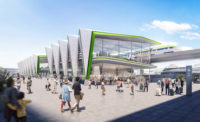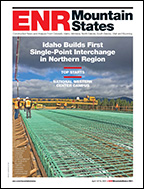TP crews began truss erection by assembling the lightest pair on 33rd Street and then picking each truss and setting it in place. To protect rails and provide work surfaces, crews then installed permanent concrete plank on the bottom chord and metal deck on the top chord. Infill steel followed in the 5 ft between trusses.
Crews then set each truss section of the second pair on assembly jigs directly atop the first pair. When the two trusses were assembled, cranes only had to move them 30 ft into final position. The assemble-and-move operation was then repeated for the remaining pairs.
Crews assembled each double truss during a 6 p.m. to 8 p.m. track outage. The next night, during the same time, they moved the pair into final position.
Hands-On Style
Related's being in the weeds takes many forms. When it looked as if the plan for a third Amtrak tunnel might throw a wrench in the Hudson Yards schedule, Related offered to manage the project, with TP as the contractor, so that it could be done before Hudson Yards covered the site. Related is applying the same delay-avoidance approach to the city's plan to raise 33rd Street.
Another strategy for success is using a Related-owned mechanical contractor, which Wackrow says cut the cost by 10%. And sections of curtain wall are coming from Related's own plant in Pennsylvania.
To keep work moving, Wackrow has teams for each main component of the development, including project management; discipline management, such as structural, enclosure and utilities; operations and support; and finance and cost control. He also has Hudson Yards general directors for the different disciplines and tasks, including safety and security, risk management and procurement.
Lines of communication stay open so that problems can be resolved as they are discovered, says Wackrow.
Wackrow's management strategy seems to be working. So much so, he says, that Related is using the Hudson Yards project as "an incubator to develop best practices for the company."















Post a comment to this article
Report Abusive Comment